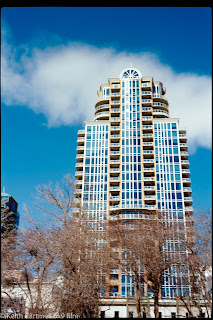To sum up the story so far, I bought a Fujica GW690, but it needed some TLC. It's off getting that, and I'm shooting a similar camera, a GL690. If you're interested in the differences between them you'll go look it up, or you know already. If not, you're already scrolling down.
I shot a roll of B&W on the way home, and two more of Portra 160 on a ramble with buddies in East Village. It's all a learning experience. Out of the 24 possible photos, I ended up with 11 that weren't horrible, although 3 of them are a special case I'll get into later. Which, all things considered, is better than I expected.
Two of them are outright my bad, clicking the shutter by accident. Several more have soft focus, and a couple I cannot now think of why I thought that might make a good photo. One of them I took 3 different photographs of the negative, one to capture the whole frame, one quite a bit closer to zoom in on the person, and one that was about as close as I could get the lens to focus.
There are a few shots where the negative is ok, but the digital photo is not. The problem is dust and hair, and I cleaned the lens first! I really did. Our house is quite dry, so I'm suspecting static attracted the dust during the process, and it moved around. Some of the shots are better than others, and it's ok removing a few spots in Lightroom. Others, like the Quirk Creek Gas Plant, are essentially ruined because of the dust and hair showing up in the sky. If the photo itself was better composed (I should have aimed the camera slightly to the right), I'd take another photo of the negative, rather than try to clean it up. Still, I know where the plant is, and it will be there for a while, so if I want a better photo I'd start with going to get a better photo, rather than work with what I've got.
Most of what remains are the 'there I was and this is what it looks like on film' sort of shots. I'll add them to the 'Of the Day feature on my other blog. Here's the ones I like the most.
I found this shed on a side road north of Longview. This was an exposure learning thing for me, trying to balance the deep shadow with the bright early afternoon sun on the snow. I used the light meter in the shade. There was minimal editing of the film version, mostly removing some dust spots, and I'm sure if you look closely you'll find more.
For comparison, here's a similar digital shot in colour. Normally I don't go on about settings, but sometimes that will happen here, given that it might be important to understand how the photo looks. The digital camera said ISO 100, f16, 1/125. Which is about what you'd expect shooting using the sunny 16 rule. I've already learned that in harsh Alberta mid day clear sky sunlight, the sunny 16 rule will be on the over exposure side just to start.
And converted to B&W.
These were not shot to be a comparison between the qualities of digital and film. Digital is digital, and film is film, and I believe that there's a time and place for each. All of these photos are lightly edited.
A selfie after coffee and a treat. Again, the composition is somewhat off.
The downtown Calgary public library is awesome! I've shot the inside, as has probably every other photographer in town. I liked the light on the curved wood, and again, this is an exposure learning shot.
And the aforementioned multiple tries of the same negative. Ann was happy to pose, but this is not a carefully thought out portrait. We wanted to get on with coffee. Again, this is a tough exposure in the mid day light and her face is a little over exposed, especially in the third shot. I tried dealing with that, but didn't go that well, and I didn't want to put a lot of time into it. If I want a better shot of this, I'd start by buying her a coffee and getting a better shot on film.
Mainly I wanted to see what detail would be in the negative, and how close I could shoot with the macro lens during the scanning process. These are all the full camera shot, with no zooming or cropping. Looking at photo 3 in Lightroom you can still see the fine individual hairs and fabric details in the scarf and camera strap. Zooming in further, however, it begins to pixelate.
So if I want a really detailed image, I could shoot the negative in 3 portrait orientation shots, and stitch them together in Lightroom. That would be about 6240 px by 9360 px wide. If I did everything right, putting the camera on a tripod, absolutely nailing the focus, using a really fine-grained film, and being really careful with the scanning photos, I could probably get a gigapixel image of 9 photos to stitch together. I can't imagine why I'd do such a thing, unless someone wanted a huge detailed print of something. Huge. Detailed.



So, more learnings:
- Clean the lens even better!
- Check the mirror and sensor for dust.
- Try to control the static, though I confess I don't know how to do this.
- Really work on exposure and focus. This not a camera for snap shots.
In other news, I've got a roll of 35 mm film in to London Drugs for developing and scan. As a reminder, I'll post the other images with some commentary in the Of the Day feature on my other blog, here, spread over a bunch of days. Stay tuned!









































